A Low-Cost Dual-Frequency Dual-Polarized Antenna Array with High Gain
Abstract
1. Introduction
2. Antenna Configuration
3. Antenna Design
3.1. Low-Loss Feed Network
3.2. Dual-Frequency Dual-Polarization Subarray
4. Experimental Results
4.1. Fabrication of the 32 × 32-Element Array
4.2. Bandwidth
4.3. Radiation Patterns
5. Conclusions
Author Contributions
Funding
Data Availability Statement
Conflicts of Interest
References
- Awida, M.H.; Suleiman, S.H.; Fathy, A.E. Substrate-integrated cavity-backed patch arrays: A low-cost approach for bandwidth enhancement. IEEE Trans. Antennas Propag. 2011, 59, 2865–2871. [Google Scholar] [CrossRef]
- Herranz-Herruzo, J.I.; Valero-Nogueira, A.; Ferrando-Rocher, M.; Bernardo, B.; Vila, A.; Lenormand, R. Low-Cost Ka-Band Switchable RHCP/LHCP Antenna Array for Mobile SATCOM Terminal. IEEE Trans. Antennas Propag. 2018, 66, 2661–2666. [Google Scholar] [CrossRef]
- Zhang, M.; Yamamoto, T.; Hirokawa, J.; Ando, M. A Wideband Circularly Polarized Corporate-Fed Waveguide Aperture Array in the 60 GHz Band. IEEE Antennas Wirel. Propag. Lett. 2021, 20, 1824–1828. [Google Scholar] [CrossRef]
- Miura, Y.; Hirokawa, J.; Ando, M.; Shibuya, Y.; Yoshida, G. Double-layer full-corporate-fed hollow-waveguide slot array antenna in 60-GHz band. IEEE Trans. Antennas Propag. 2011, 59, 2844–2851. [Google Scholar] [CrossRef]
- Guler, G. Dual Polarized Slotted Array Antenna. U.S. Patent 6127985, 3 October 2000. [Google Scholar]
- Wu, Y.; Hirokawa, J.; Tomura, T. Dual-Polarized Full-Metal Perpendicular-Corporate-Feed Parallel-Plate Waveguide Slot Array Antenna. IEEE Trans. Antennas Propag. 2024, 72, 6093–6098. [Google Scholar] [CrossRef]
- Koli, M.N.Y.; Afzal, M.U.; Esselle, K.P. Increasing the Gain of Beam-Tilted Circularly Polarized Radial Line Slot Array Antennas. IEEE Trans. Antennas Propag. 2022, 70, 4392–4403. [Google Scholar] [CrossRef]
- Faenzi, M.; Graziuso, N.; Martini, E.; Maci, S. Design Methods for Dual Polarized Metasurface Antennas: Three Simple Approaches. IEEE Antennas Propag. Mag. 2022, 64, 37–50. [Google Scholar] [CrossRef]
- Pla, V.; Valero-Nogueira, A.; Herranz, J.I.; Alfonso, E.; Rodrigo, V. Dual linearly polarized single-layer radial-line slot-array antenna. IEEE Antennas Wirel. Propag. Lett. 2006, 5, 120–122. [Google Scholar] [CrossRef]
- De Marco, R.; Arnieri, E.; Greco, F.; Bordbar, A.; Amendola, G.; Boccia, L. Low-Profile Dual-Band Dual-Polarized Transmit array Antenna Based on Multilayer Frequency Selective Surfaces. IEEE Trans. Antennas Propag. 2023, 71, 7354–7362. [Google Scholar] [CrossRef]
- Wong, K.L. Compact and Broadband Microstrip Antennas; Chapter 4; Wiley: New York, NY, USA, 2002. [Google Scholar]
- Deepukumar, M.; George, J.; Aanandan, C.K.; Mohanan, P.; Nair, K.G. Broadband dual frequency microstrip antenna. Electron. Lett. 1996, 32, 1531–1532. [Google Scholar] [CrossRef]
- Chen, J.-S.; Wong, K.-L. A single-layer dual-frequency rectangular microstrip patch antnna using a single probe feed. Microw. Opt. Technol. Lett. 1996, 11, 83–84. [Google Scholar] [CrossRef]
- Nakano, H.; Vichien, K. Dual-frequency square patch antenna with rectangular notch. Electron. Lett. 1989, 25, 1067–1068. [Google Scholar] [CrossRef]
- Liu, R.; Tian, X.; Sima, B.; Sun, Z.; Yu, Y.; Cao, H. A Dual-Polarized Dual-Band Patch Antenna Based on Orthogonal Modes Manipulation. Int. J. Antennas Propag. 2022, 2022, 2879735. [Google Scholar] [CrossRef]
- Li, J.; Yang, S.; Li, B.; Nie, Z. A low profile dual-band dual-polarized patch antenna array with integrated feeding network for pico-base station applications. Microw. Opt. Technol. Lett. 2014, 56, 1594–1600. [Google Scholar] [CrossRef]
- Nisha, M.S.; Sarin, V.P.; Gijo, A.; Deepu, V.; Anandan, C.K.; Mohanan, P.; Vasudevan, K. Compact dual frequency dual polarized cross patch antenna with an X-slot. Microw. Opt. Technol. Lett. 2008, 50, 3198–3201. [Google Scholar] [CrossRef]
- Wang, M.; Wu, W.; Fang, D.-G. Uniplanar single corner-fed dual-band dual-polarization patch antenna array. Prog. Electromagn. Res. Lett. 2012, 30, 41–48. [Google Scholar] [CrossRef]
- Mathur, P.; Kumar, G. Dual-frequency dual-polarised shared-aperture microstrip antenna array with suppressed higher order modes. IET Microw. Antennas Propag. 2019, 13, 1300–1305. [Google Scholar] [CrossRef]
- Levine, E.; Malamud, G.; Shtrikman, S. A study of microstrip array antennas with the feed network. IEEE Trans. Antennas Propag. 1989, 37, 426–434. [Google Scholar] [CrossRef]
- Russell, K.J. Microwave power combining techniques. IEEE Trans. Microw. Theory Tech. 1979, 27, 472–478. [Google Scholar] [CrossRef]
- Song, K.; Fan, Y.; He, Z. Broadband radial waveguide spatial combiner. IEEE Microw. Wirel. Compon. Lett. 2008, 18, 73–75. [Google Scholar] [CrossRef]
- Shan, X.; Shen, Z. A suspended-substrate Ku-band symmetric radial power combiner. IEEE Microw. Wirel. Compon. Lett. 2011, 21, 652–654. [Google Scholar]
- Pozar, D.M. Microwave Engineering, 3rd ed.; Chapter 3; Wiley: New York, NY, USA, 2005. [Google Scholar]
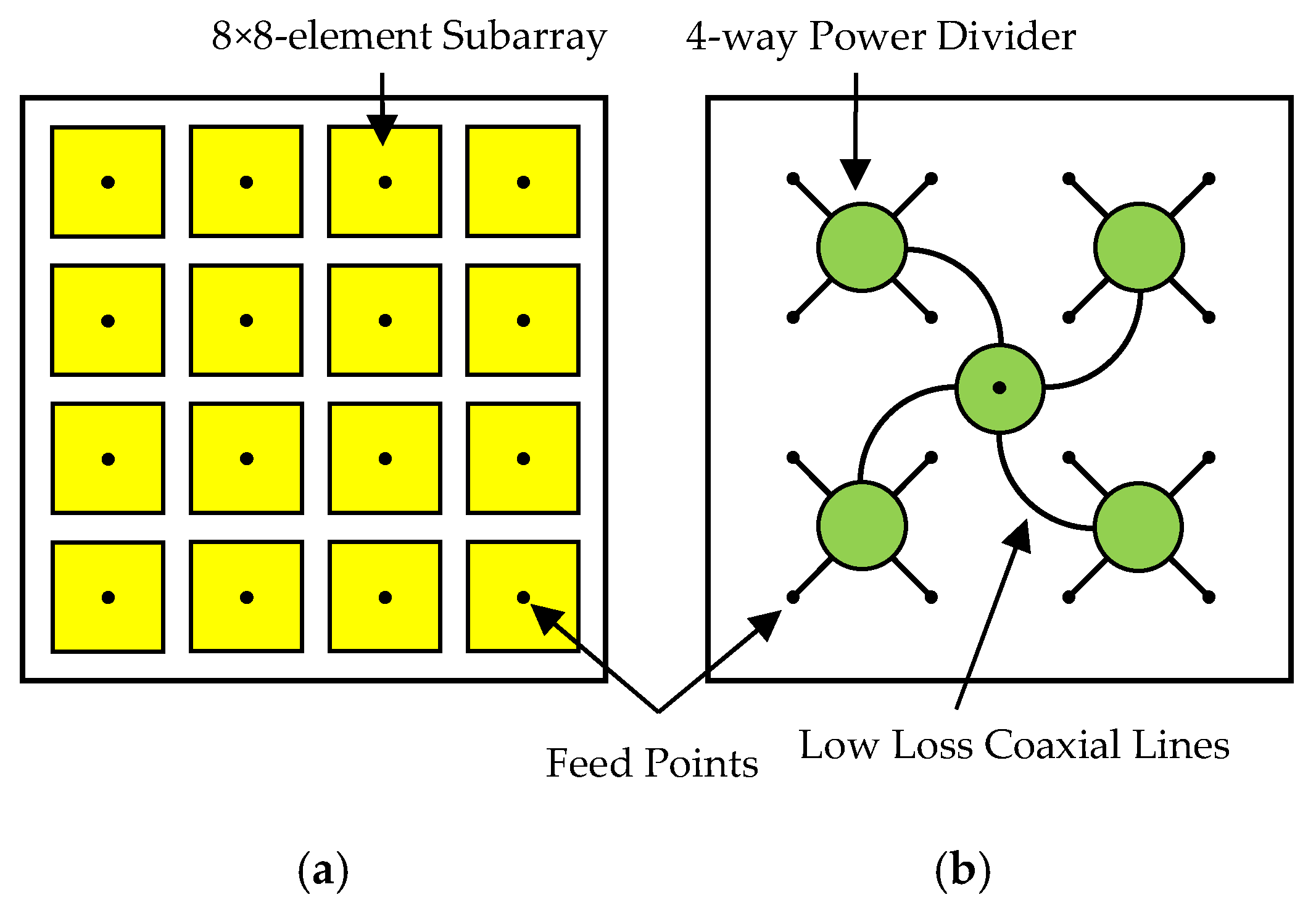
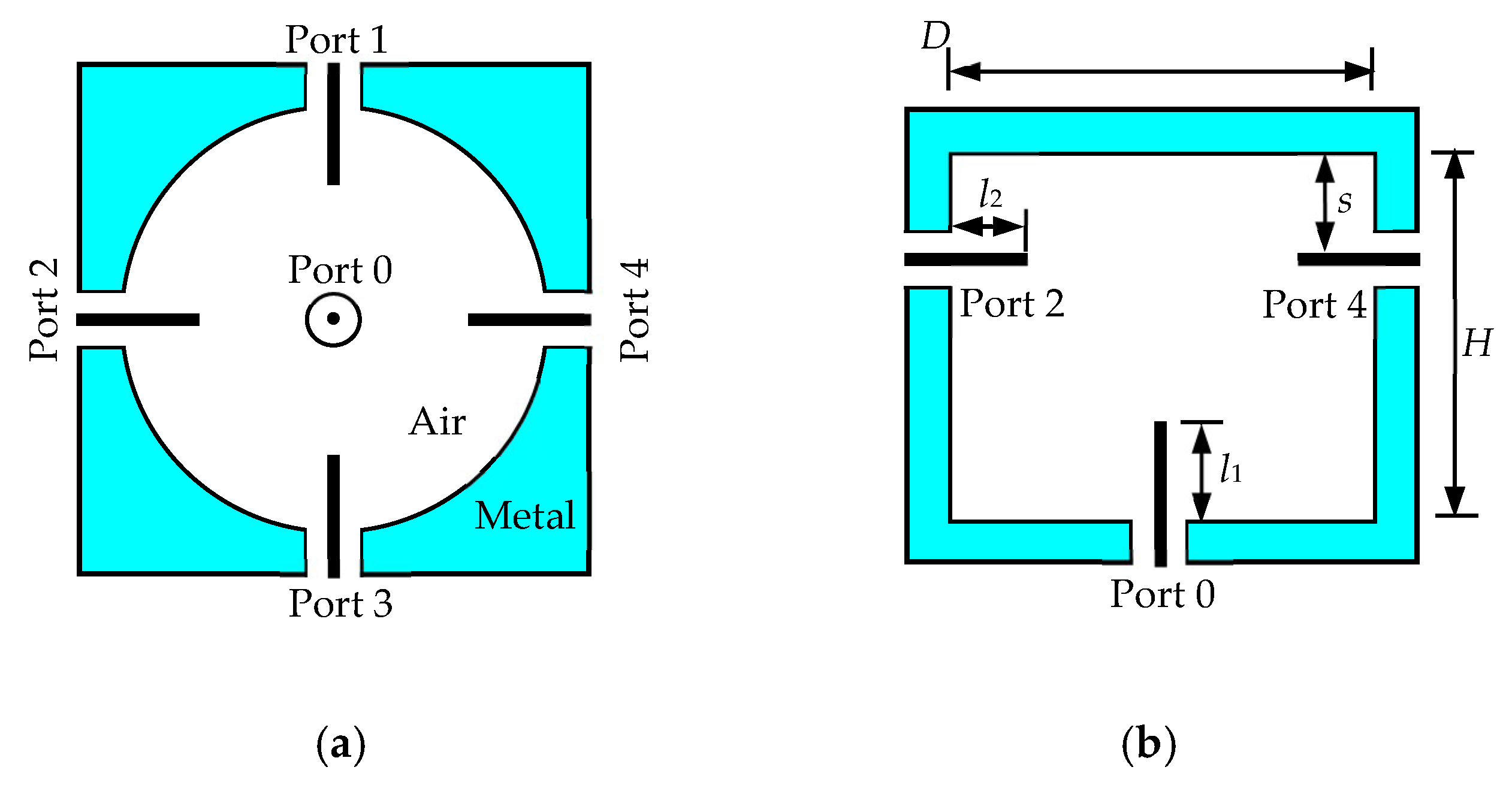
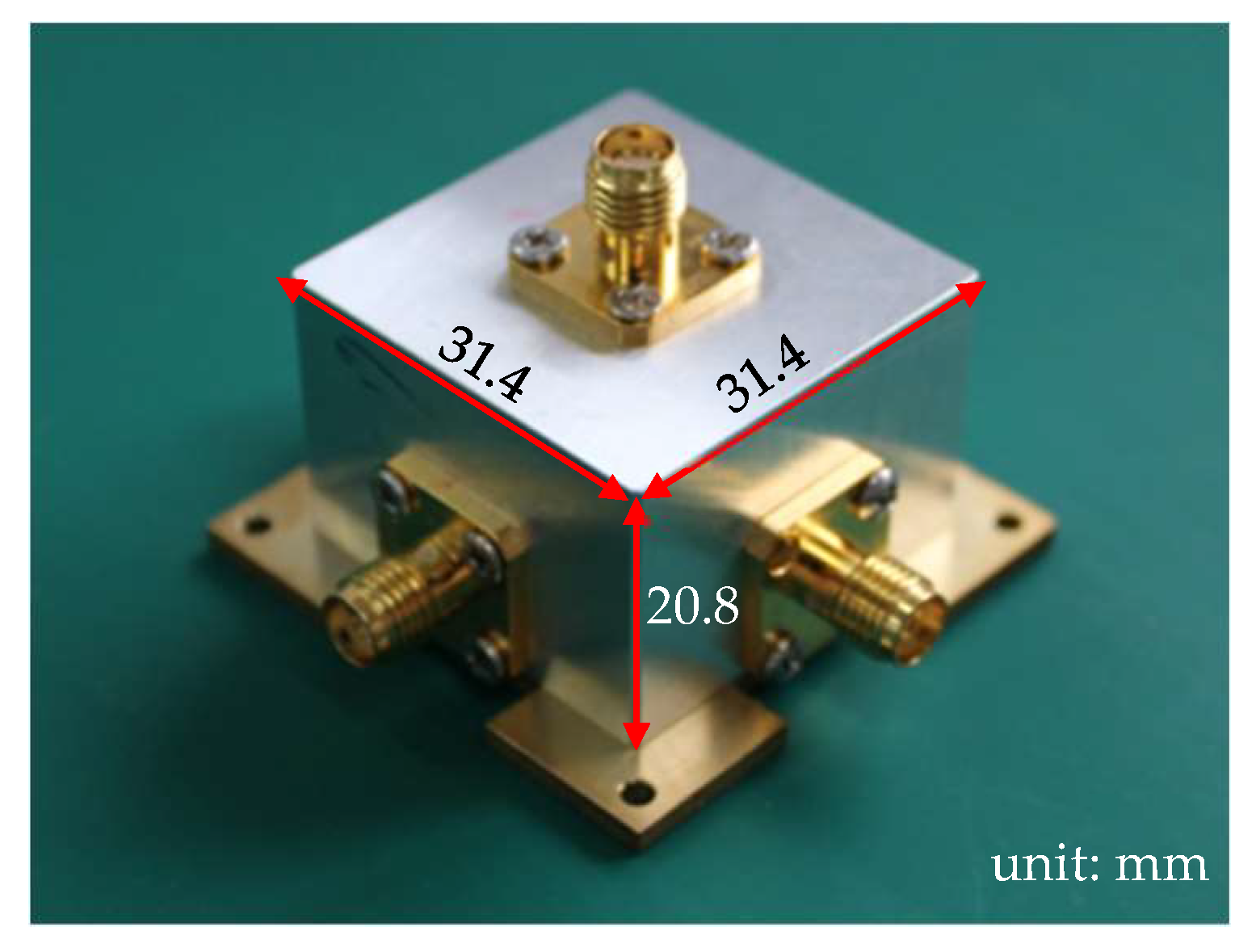

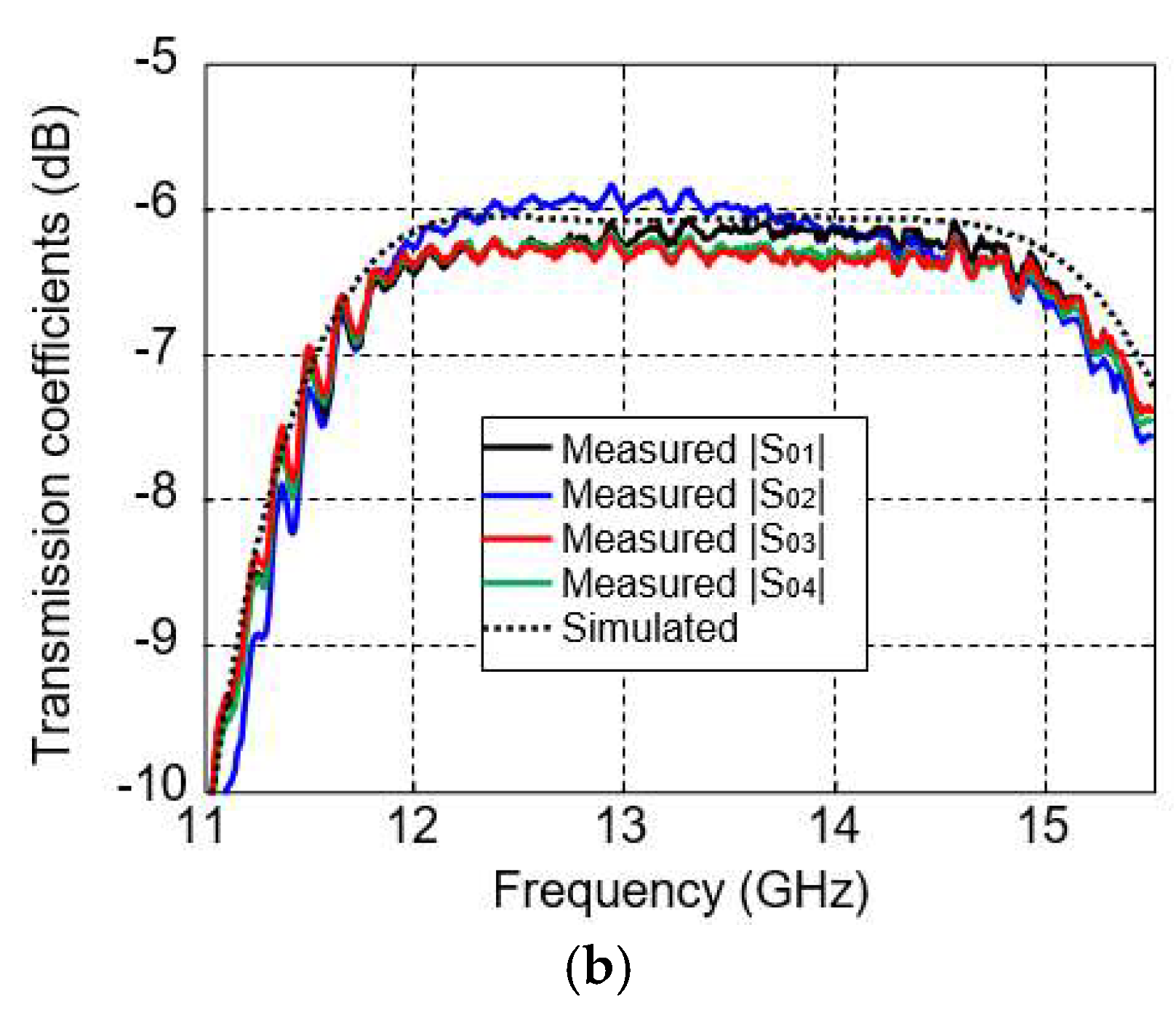
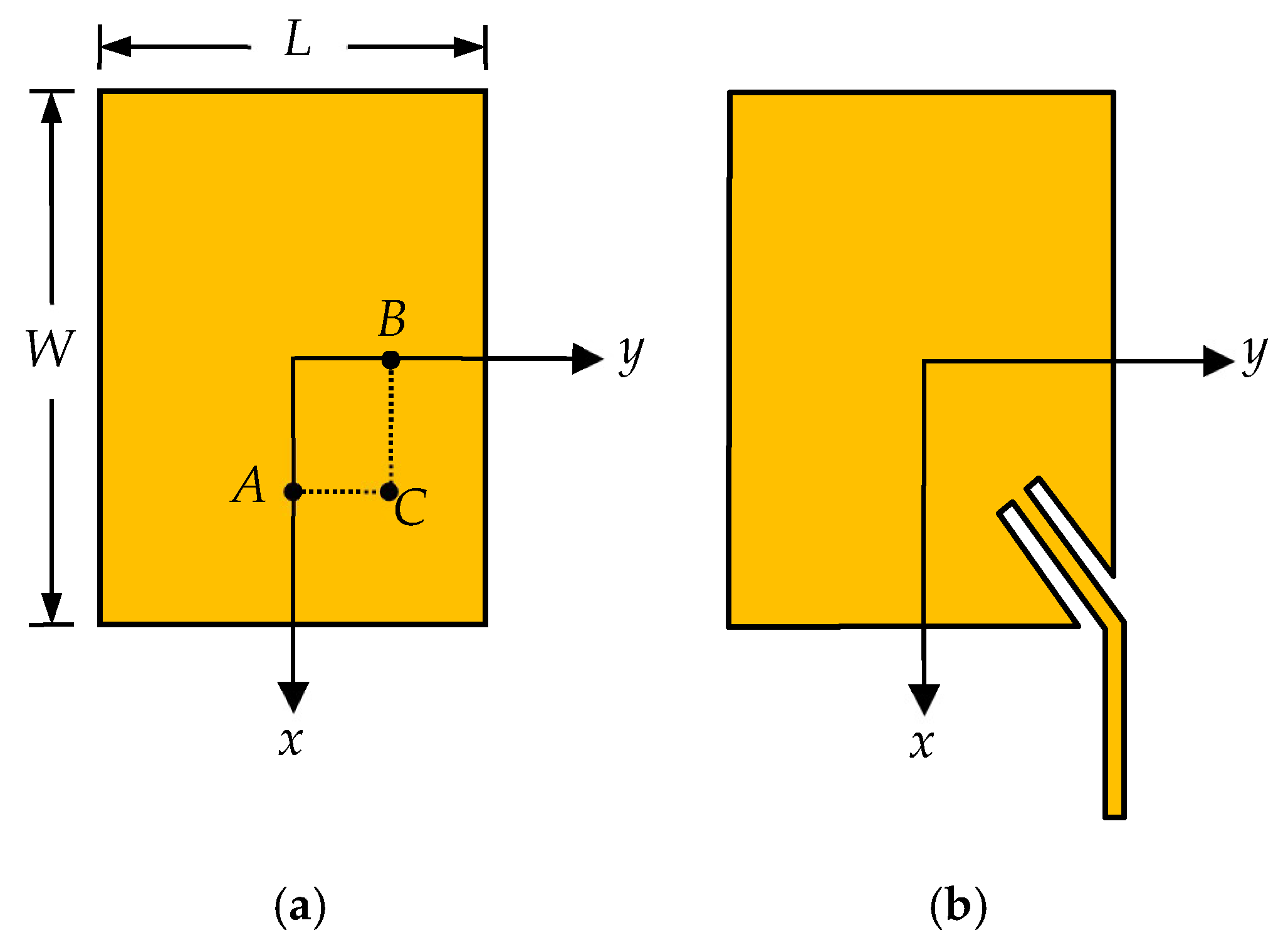
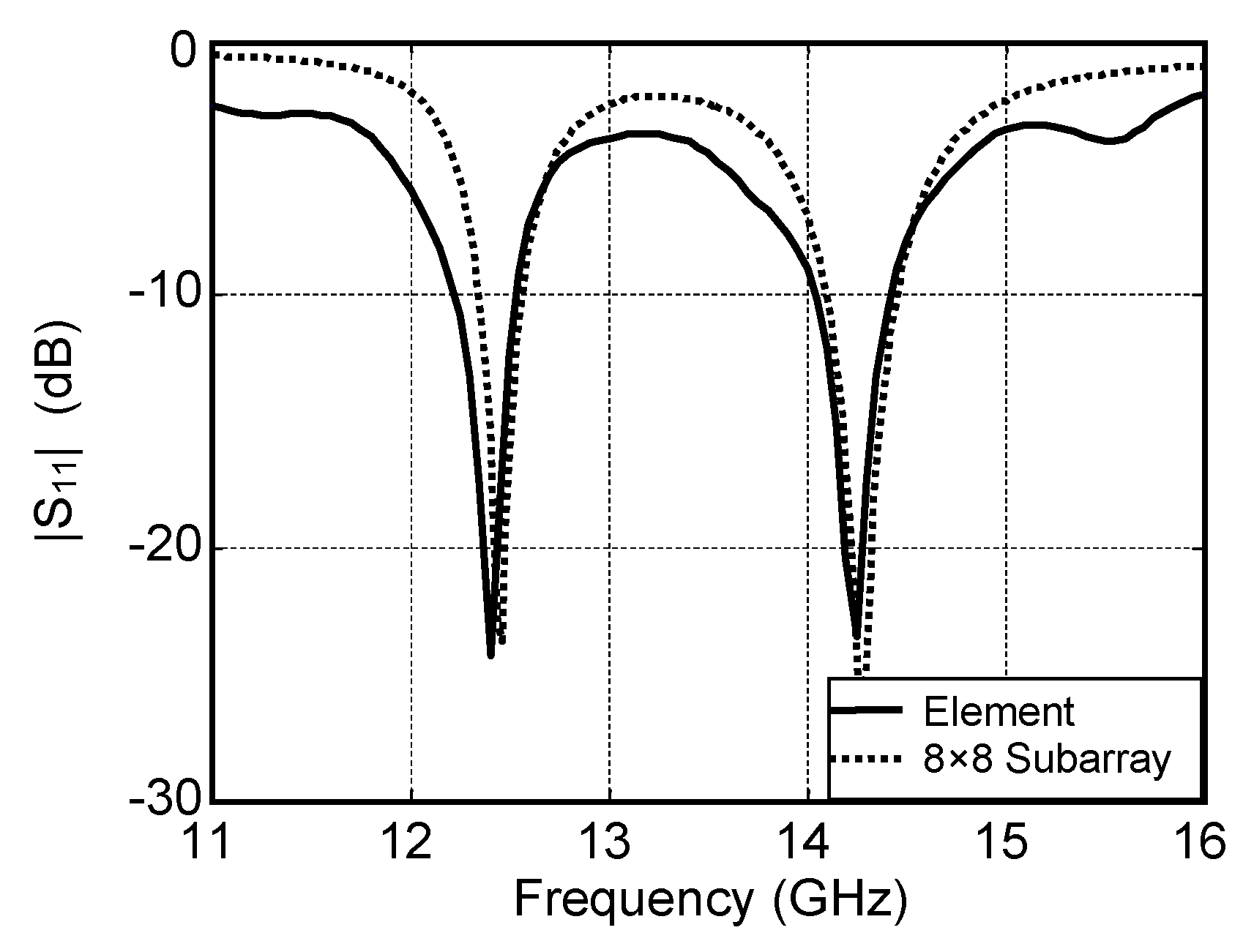
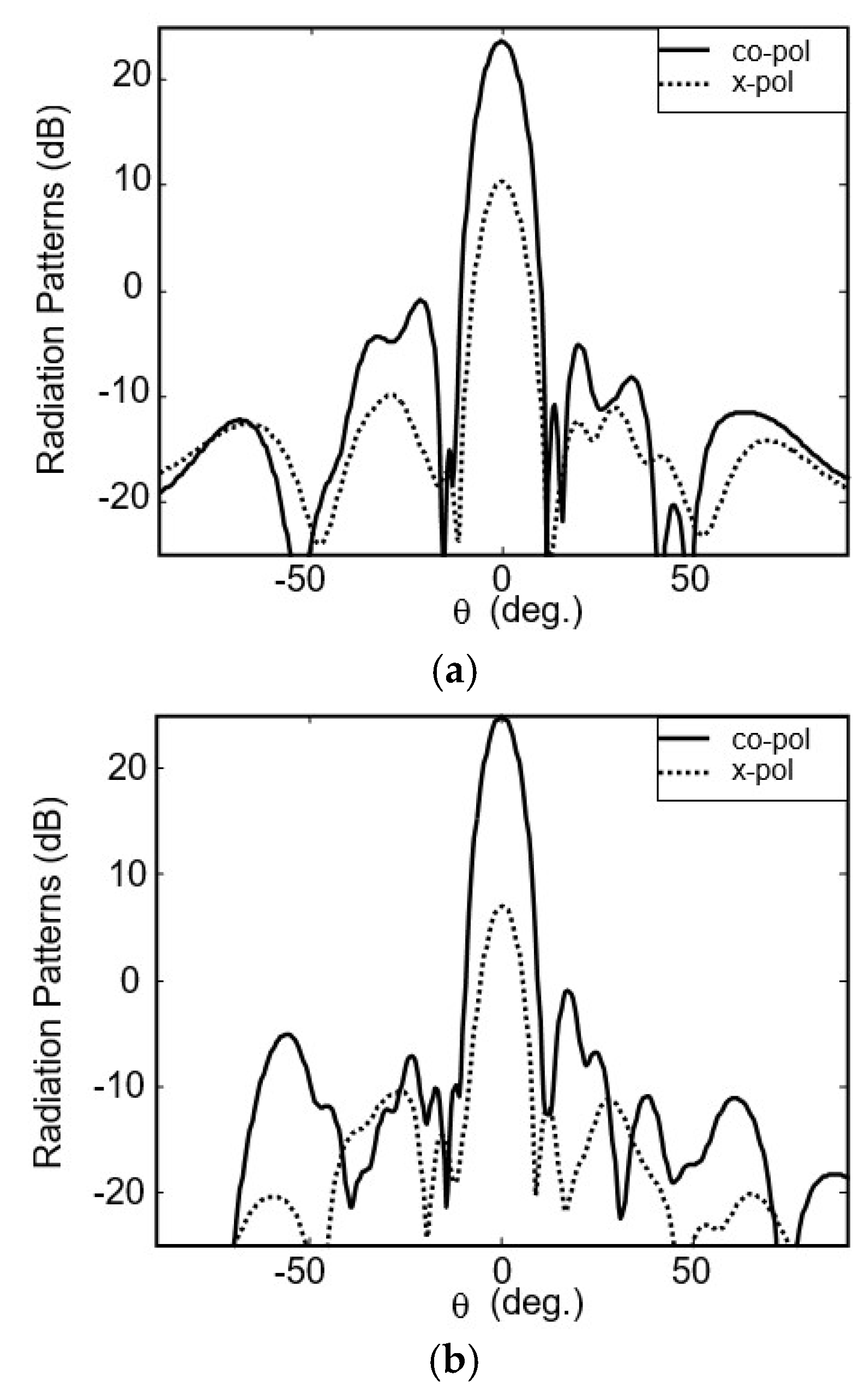
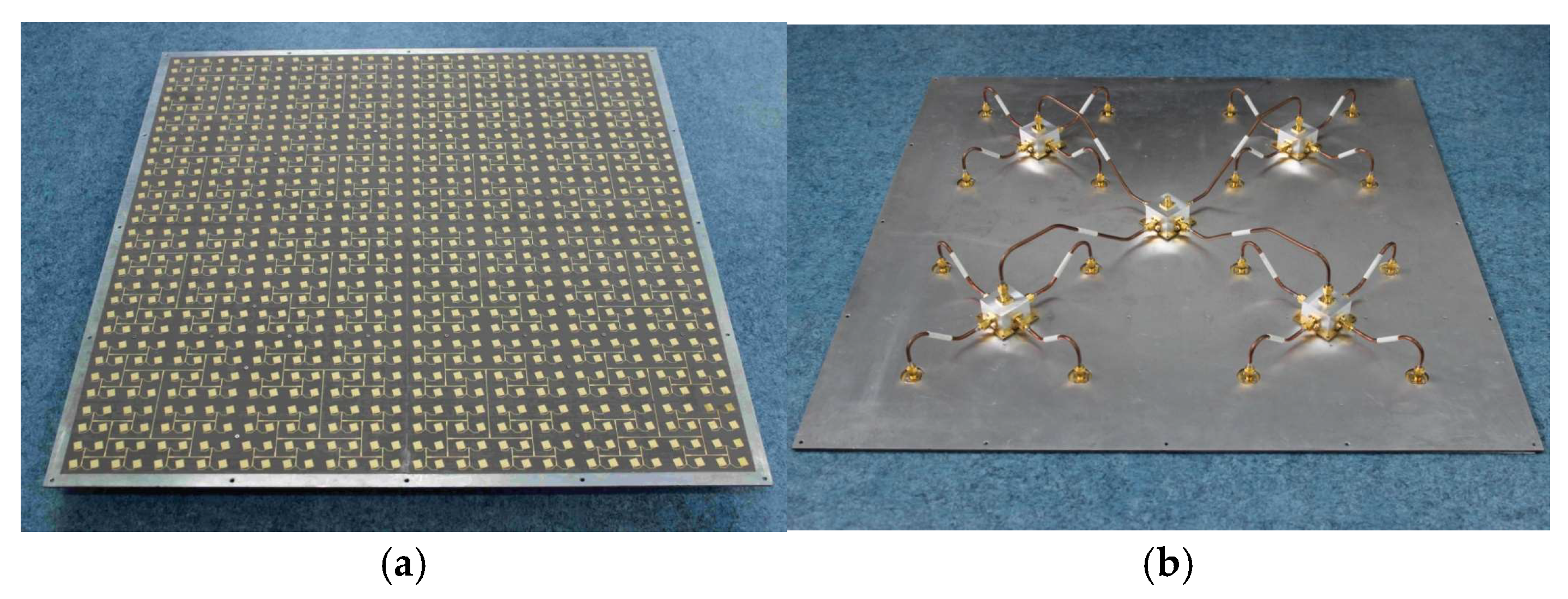

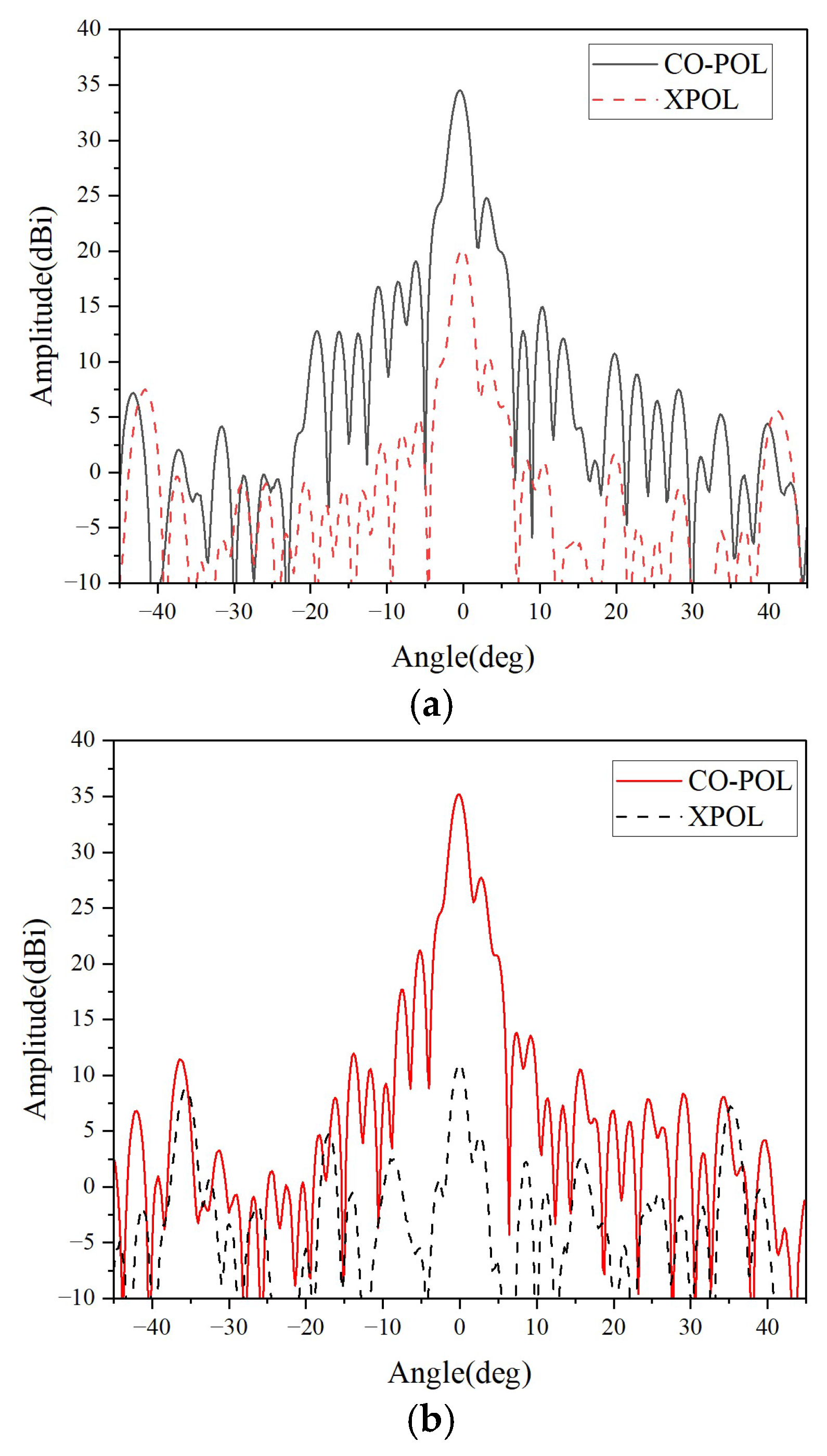
| Parameters | Initial Values | Final Values |
|---|---|---|
| H | λg/2 = 15.32 mm | 16.8 mm |
| s | λg/4 = 7.66 mm | 6.1 mm |
| l1 | λg/4 = 7.66 mm | 6.0 mm |
| l2 | λ0/2 = 5.61 mm | 5.3 mm |
| Size of Subarray | Loss in Subarray (dB) | Loss in Separate Feed Network(dB) | Sum (dB) | |
|---|---|---|---|---|
| Power Divider Loss (dB) | Semi-Ridged Coaxial Lines Loss (dB) | |||
| 2 × 2 | 0.3 | 4 × 0.3 = 1.2 | 4 × 0.3 = 1.2 | 2.7 |
| 4 × 4 | 0.6 | 3 × 0.3 = 0.9 | 3 × 0.3 = 0.9 | 2.4 |
| 8 × 8 | 1.2 | 2 × 0.3 = 0.6 | 2 × 0.3 = 0.6 | 2.4 |
| 16 × 16 | 2.4 | 1 × 0.3 = 0.3 | 1 × 0.3 = 0.3 | 3.0 |
| 32 × 32 | 4.8 | 0 | 0 | 4.8 |
| Ref. | Gain dBi | Operating Band GHz | Sidelobe dB | Polarization Isolation dB | Aperture Efficiency | Fabrication Complexity |
|---|---|---|---|---|---|---|
| [6] | 32.3 | 58.0–63.4 (8.8%) | −12 | −43 | 60% | High |
| [10] | 20.6 22.8 | 20 30 | −10 −13.5 | −25 −20 | 27% 23% | Medium |
| [15] | 5.57 6.82 | 10.38 (1.1%) 13.9 (3.8%) | -- | −13 −19 | 12.3% 11.1% | Medium |
| [16] | 10.7 11.7 | 1.92–1.98 (9.2%) 2.11–2.17 (5.58%) | -- | −21 −19 | 74.8% 78.2% | Low |
| [17] | 4.6 3.3 | 1.42 1.79 | -- | −12 −10 | -- | Low |
| [19] | 8.0 11.5 | 2.7 (7.4%) 8.1 (8.7%) | -- | −18 −22 | 31.6% 7.9% | High |
| This work | 34.5 35.2 | 12.04–12.69 (5.2%) 13.82–14.66 (5.9%) | −10 −8.5 | −15 −25 | 38.9% 35.2% | Low |
Disclaimer/Publisher’s Note: The statements, opinions and data contained in all publications are solely those of the individual author(s) and contributor(s) and not of MDPI and/or the editor(s). MDPI and/or the editor(s) disclaim responsibility for any injury to people or property resulting from any ideas, methods, instructions or products referred to in the content. |
© 2025 by the authors. Licensee MDPI, Basel, Switzerland. This article is an open access article distributed under the terms and conditions of the Creative Commons Attribution (CC BY) license (https://creativecommons.org/licenses/by/4.0/).
Share and Cite
Zhang, J.-D.; Wang, M.; Wu, W. A Low-Cost Dual-Frequency Dual-Polarized Antenna Array with High Gain. Micromachines 2025, 16, 1183. https://doi.org/10.3390/mi16101183
Zhang J-D, Wang M, Wu W. A Low-Cost Dual-Frequency Dual-Polarized Antenna Array with High Gain. Micromachines. 2025; 16(10):1183. https://doi.org/10.3390/mi16101183
Chicago/Turabian StyleZhang, Jin-Dong, Min Wang, and Wen Wu. 2025. "A Low-Cost Dual-Frequency Dual-Polarized Antenna Array with High Gain" Micromachines 16, no. 10: 1183. https://doi.org/10.3390/mi16101183
APA StyleZhang, J.-D., Wang, M., & Wu, W. (2025). A Low-Cost Dual-Frequency Dual-Polarized Antenna Array with High Gain. Micromachines, 16(10), 1183. https://doi.org/10.3390/mi16101183





